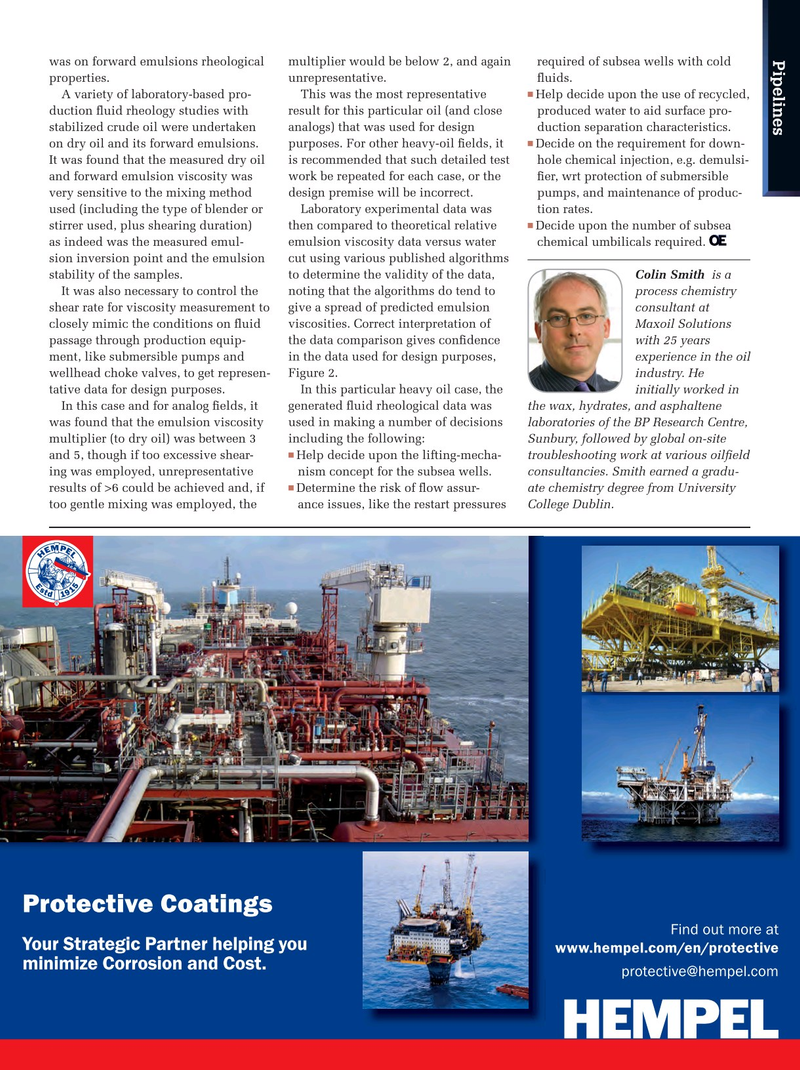
Page 111: of Offshore Engineer Magazine (Sep/Oct 2013)
Read this page in Pdf, Flash or Html5 edition of Sep/Oct 2013 Offshore Engineer Magazine
Pipelines was on forward emulsions rheological multiplier would be below 2, and again required of subsea wells with cold properties. unrepresentative. fuids.
n
A variety of laboratory-based pro- This was the most representative Help decide upon the use of recycled, duction fuid rheology studies with result for this particular oil (and close produced water to aid surface pro- stabilized crude oil were undertaken analogs) that was used for design duction separation characteristics.
n on dry oil and its forward emulsions. purposes. For other heavy-oil felds, it Decide on the requirement for down-
It was found that the measured dry oil is recommended that such detailed test hole chemical injection, e.g. demulsi- and forward emulsion viscosity was work be repeated for each case, or the fer, wrt protection of submersible very sensitive to the mixing method design premise will be incorrect. pumps, and maintenance of produc- used (including the type of blender or Laboratory experimental data was tion rates.
n stirrer used, plus shearing duration) then compared to theoretical relative Decide upon the number of subsea as indeed was the measured emul- emulsion viscosity data versus water chemical umbilicals required. sion inversion point and the emulsion cut using various published algorithms stability of the samples. to determine the validity of the data, Colin Smith is a
It was also necessary to control the noting that the algorithms do tend to process chemistry shear rate for viscosity measurement to give a spread of predicted emulsion consultant at closely mimic the conditions on fuid viscosities. Correct interpretation of Maxoil Solutions passage through production equip- the data comparison gives confdence with 25 years ment, like submersible pumps and in the data used for design purposes, experience in the oil wellhead choke valves, to get represen- Figure 2. industry. He tative data for design purposes. In this particular heavy oil case, the initially worked in
In this case and for analog felds, it generated fuid rheological data was the wax, hydrates, and asphaltene was found that the emulsion viscosity used in making a number of decisions laboratories of the BP Research Centre, multiplier (to dry oil) was between 3 including the following: Sunbury, followed by global on-site n and 5, though if too excessive shear- Help decide upon the lifting-mecha- troubleshooting work at various oilfeld ing was employed, unrepresentative nism concept for the subsea wells. consultancies. Smith earned a gradu- n results of >6 could be achieved and, if Determine the risk of fow assur- ate chemistry degree from University too gentle mixing was employed, the ance issues, like the restart pressures College Dublin.
Protective Coatings
Find out more at
Your Strategic Partner helping you www.hempel.com/en/protective minimize Corrosion and Cost.
[email protected] 000_OE0913_pipelines_maxoil.indd 113 8/17/13 5:56 PM
Typ 09 - P7_General Offshore - 138x203.indd 1 2013-07-12 15:00:33

 110
110

 112
112